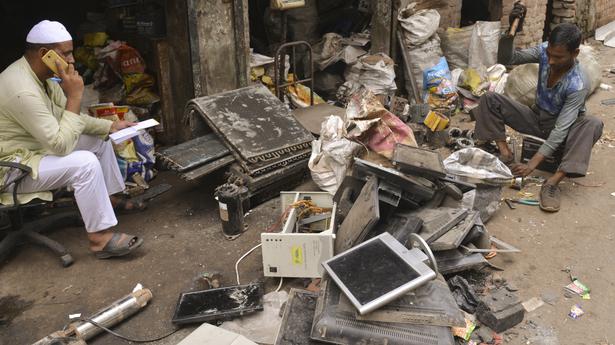
New rules spur opportunities for e-waste recyclers
The Hindu
Draft rules in public domain for consultation
Over the next five years, Delhi-NCR-headquartered Attero Recycling, one of India’s largest electronic waste management companies, expects to invest close to $1 billion in expanding their electronic waste recycling facilities. More than 70% of it is for setting up operations in Europe, the United States and Indonesia to recycle lithium-ion batteries premised on the increasing share of electric vehicles in the years ahead. Nitin Gupta, Co-founder and CEO of the company says that while lithium batteries may be the future for the company, the present is hinged on the growing number of electronic waste that his factory in Roorkee is processing. Credit, he says, is due to the mandatory recycling targets that electronics-goods makers have been set under the Electronic Waste Management Rules, 2016. From 30% of sales in 2018, companies are expected to recycle 70% of their sales by 2023.
“Prior to the EPR regime, recyclers like us had to pay to procure e-waste. We extract the precious metals and sell them. The informal recyclers use hazardous methods and therefore were able to do this at a lower cost. Even if their recovery (of metals) was low, their costs were low and so profitable, Now with the EPR regime, it’s Original Equipment Manufacturers who are paying for recycling and a lot more is collected in the formal sector,” said Gupta.
The slew of technological processes deployed at his organisation helped extract nearly 98% of valuable copper, gold, tin, lithium, palladium, nickel, cobalt within electronic devices. “We have developed these technologies in-house and have close to 20 patents on these processes. The increasing emphasis on the formalisation of the recycling means that India, in the years ahead, can reduce dependence on imports of precious metals that otherwise could only be mined from foreign countries.”
Last month, the Union environment ministry unveiled a set of draft rules that further incentivises registered electronic waste recyclers. The crucial difference from the 2016 rules is the generation of EPR, or Extended Producer Responsibility, certificates. Recyclers on processing a certain quantity of waste would be given a certificate verifying this number by the Central Pollution Control Board (CPCB). Electronics goods companies can buy these certificates online from the CPCB to meet their annual targets. Recyclers can also directly contract with a company to recycle a certain quantity of waste and generate certificates that can be accessed from the CPCB.
The challenge is verifiability. How for instance, does the CPCB verify that the certificates indeed guarantee the quantity of e-waste recycled? Prior to the EPR scheme, state pollution control boards were expected to be conducting checks on recycler and monitoring if they were indeed processing the amount of waste they claimed. In the new regime, said Gupta, this verification would be done via “software matching.” A recycling company would be paying a certain amount of Goods and Services Tax (GST) annually based on the quantity of precious metal they’ had extracted and sold, said Gupta, and this would correlate to the amount of e-waste processed. This could be further matched with the certificates bought by a producer company to meet targets.
The latest e-waste rules are yet to be formally become law and the Environment Ministry has set a 60 day-period for public consultation.
Independent experts say that verifying the actual quantity recycled is next to impossible because none of the data—how many electronic goods were sold in a particular year and how much e-waste is generated and how much recycled—is available in public domain.











